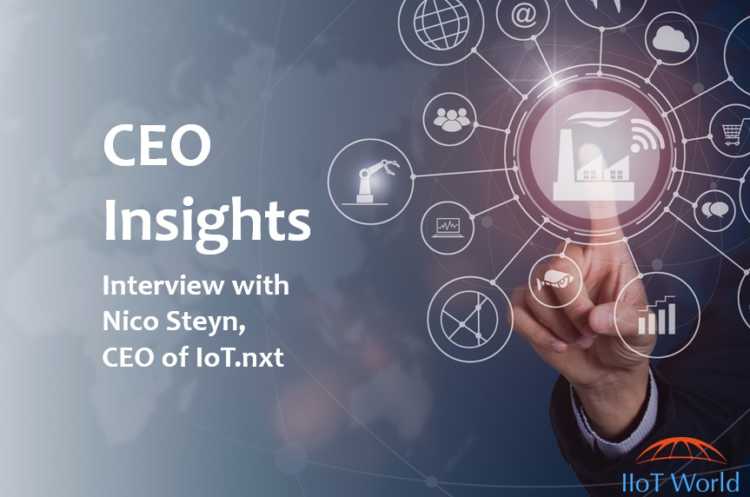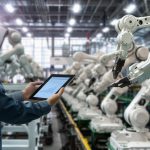CEO Insights: “The Internet of Things is about much more than just connecting devices”
Running factories from our phones, adaptive robots that work alongside with humans or 3D printing are just a few characteristics of smart manufacturing. Nico Steyn, CEO of IoT.nxt shares his thoughts about Industrial IoT, connecting devices, and the role of the Internet of Things in defining a new way of doing business.
Carol Rudinschi: Nico, from your perspective, what are the most exciting things happening in Industrial IoT?
Nico Steyn: The thing that excites me the most is the fact that there is a realization in the world that what we are achieving with Internet of Things does not only reside in the cloud, and therefore there is more and more vital debate and discussion around the power that resides in the edge. Take that thinking and combine that with tech such as artificial intelligence, machine learning and cognitive analytics and you have just entered a new realm of what is possible. This isn’t theoretical anymore. It is becoming real and people are starting to understand this. The Internet of Things is about much more than just connecting devices; new technologies unlock a new way of thinking.
Carol Rudinschi: What is the future of manufacturing and how will technology play a role?
Nico Steyn: The best way to describe the future of manufacturing is: “just in time”. What I mean by this is “I get what I need, when I need it”. I manufacture in near real-time exactly what my customer needs, and deliver it to him. The advent of 3D printing and similar technology will see large manufacturing and distribution chains as they currently exist disintermediated.
The connected nature towards which we are migrating will allow manufacturers to better understand what their customers require on a real-time basis. This in turn enables the manufacturer to recalibrate not only the actual manufacturing part of the business and what they procure, but also to become highly competitive, super in-tune with what their customer requirements are, down to quality requirements per customer. That transparency will drive product improvement and customer satisfaction to new levels. Manufacturers will not order more raw material than they need.
Think about latency and how this will be addressed. Consider this example: a customer wants a product; there’s the procurement of materials, import, export, shipping, logistics, manufacturing – it can take up to six months or more. Whereas, utilising IoT and technology such as ever-improving 3D printing, the manufacturer could print the product on site and deliver the next morning. The future of manufacturing is built on an entire paradigm shift.
Carol Rudinschi: What factors do you think would most accelerate the adoption of the Internet of Things in manufacturing?
Nico Steyn: Proof of value and return on investment. Various organizations around the world have commissioned studies into Industrial IoT, as have we in the form of surveys and real-life feedback from meeting with business leaders, and the most immediate obstacle to the rollout of IoT platforms is proof of value. Once return on investment can be demonstrated – and it always is – companies are comfortable rolling out across their business.
Another factor obstructing IoT rollout in some instances is the existing investment in legacy systems. With a rip-and-replace approach to Internet of Things the costs are staggering, and for many manufacturers who are already operating on tight margins this reality is not palatable.
We have found that by being able to retrofit onto existing legacy systems and prove how an IoT rollout supports the business strategy, the business case for IoT rollout is clear.
Carol Rudinschi: Is security in conflict with interoperability and connected devices?
Nico Steyn: No, I don’t believe security is in conflict with connected devices. On the contrary, I think it intrinsically must form part of it. The reality is that security is going to become key moving forward, and therefore it must become pervasively embedded inside the platform and inside the reference architecture of IoT.
Therefore, moving forward it is going to become increasingly important to ensure that whatever technologies, platforms and devices you are deploying, that they conform to a standard, and therefore I also think that the argument is made that less will be more. From a security perspective, contrary to general IoT commentary, you actually need to have less of an ecosystem and fewer ecosystem partners, putting you in a position to more securely lock down key points of vulnerability.
Carol Rudinschi: What’s the one piece of advice for a business leader interested in getting started with an IIoT?
Nico Steyn: The most important thing for any business leader today is: do not vacillate. Get moving, get started, get something happening, don’t make one big bet – what you need to do is strategically understand what the key drivers are within your business and then implement thin-slice, rapid deployment.
We talk about proof of value; in other words, understand your business case, get someone who can bring the technology to the table that can address that, obviously taking into consideration the bigger picture in terms of interoperability and interconnectivity, but deploy it sooner than later and if it doesn’t work, fail fast. In other words, the key for any business leader is understanding that indecision will cost you dearly. The cost of failure is far outweighed by the cost of inaction.
Inaction results in extinction. We are hearing reports from some of the top consulting firms who are predicting that up to 40% of Fortune 500 companies as they stand today will not rank in the Top 500 in the next five years. So, there is a major shift happening and the reality is that leaders need to step up, understand where they want to take their business and realize they need to embark on the journey of digital transformation or run the risk of being left behind, being outsmarted or outclassed completely.
Carol Rudinschi: In what interesting IIoT projects/case studies have you been involved with?
Nico Steyn: Our approach to Internet of Things and our technology stack is interesting as it hasn’t been developed as an application but rather as a real platform on which organizations can build their future digital strategies. It has been developed and designed as a framework with horizontal integration capabilities, but also to run in multiple vertical industries. Currently we are deployed into 13 different industries in 20 different use cases.
What excites me is our capability to deploy into multiple industries, not in an off-the-shelf fashion, but rather sitting with a business leader, understanding what it is that they require to move the dial within their business and then in a relatively brief time span being able to deliver a business-specific solution that helps these business leaders transform their business.
I find it very exciting to see the change that deploying this technology into a business brings, not just through the technology itself but also in how people view the business differently and the new insights that hadn’t even been contemplated initially that are now possible. That is incredibly exciting. It’s a game changer!
Brief summary of business:
The failure of many IoT and Big Data platforms is their inability to – independently – completely connect all facets of an organisation. IoT.nxt provides a highly differentiated application framework that consists of intelligent proprietary gateways and a back-end data orchestration platform.
The IoT.nxt framework takes care of data acquisition, normalization, aggregation, and orchestration from the edge to enterprise level across all devices and systems, on premise or cloud.
IoT.nxt creates interoperability at a device level, filtering data at the edge and cutting costs, complexity and risk. The result is one standardized layer of data integration extending up and down the stack to achieve complete interconnectivity. The major strength of the IoT.nxt framework is that the solution is technology agnostic, which overcomes the challenge of connecting all devices or systems.



